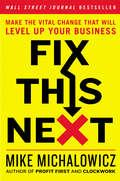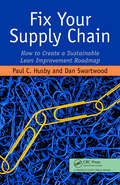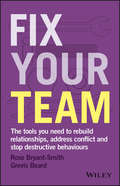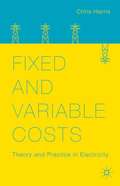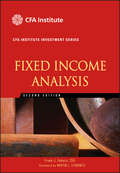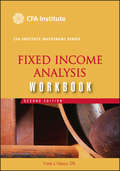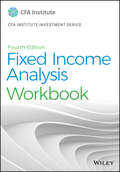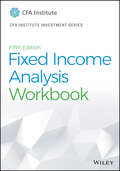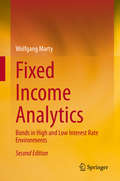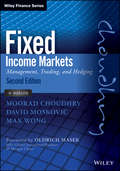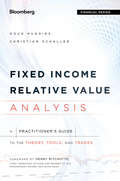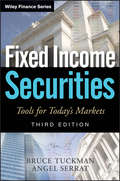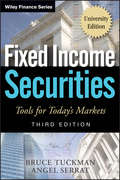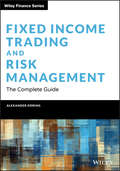- Table View
- List View
Fix This Next: Make the Vital Change That Will Level Up Your Business
by Mike MichalowiczFrom Mike Michalowicz, the author of PROFIT FIRST, CLOCKWORK, and THE PUMPKIN PLAN, comes the ultimate diagnostic tool for every entrepreneur.The biggest problem entrepreneurs have is that they don't know what their biggest problem is. If you find yourself trapped between stagnating sales, staff turnover, and unhappy customers, what do you fix first? Every issue seems urgent -- but there's no way to address all of them at once. The result? A business that continues to go in endless circles putting out urgent fires and prioritizing the wrong things.Fortunately, Mike Michalowicz has a simple system to help you eradicate these frustrations and get your business moving forward, fast. Mike himself has lived through the struggles and countless distractions of entrepreneurship, and devoted years to finding a simple way to pinpoint exactly where to direct attention for rapid growth. He figured out that every business has a hierarchy of needs, and if you can understand where you are in that hierarchy, you can identify what needs immediate attention. Simply fix that one thing next, and your business will naturally and effortlessly level-up.Over the past decade, Mike has developed an ardent following for his funny, honest, and actionable insights told through the stories of real entrepreneurs. Now, Fix This Next offers a simple, unique, and wildly powerful business compass that has already helped hundreds of companies get to the next level, and will do the same for you. Immediately.
Fix Your Supply Chain: How to Create a Sustainable Lean Improvement Roadmap
by Paul Husby Dan SwartwoodWritten by business leaders for business leaders, this book explores successful supply chain improvement requirements and improvement methodologies, along with their strengths and limitations. It covers the use of these techniques in a story about Twin City Manufacturing, a fictitious company based on the authors actual experiences. The principles
Fix Your Team: The Tools You Need to Rebuild Relationships, Address Conflict and Stop Destructive Behaviours
by Rose Bryant-Smith Grevis BeardTransform team dynamics with practical, real-world tools for sustainable change Fix Your Team is the manager’s essential and practical guide to diagnosis and intervention. Packed with expert insight acquired over decades of experience in workplace relations and conflict resolution, this book systematically addresses problems with team dynamics and provides a blueprint for moving forward. Authors Rose Bryant-Smith and Grevis Beard bring a unique combination of legal nous, conflict management expertise, emotional intelligence and business experience to provide a wealth of valuable insights, with robust tools designed for easy implementation. This book offers diagnostic guidance to help you analyse existing issues with confidence, and a clear framework for removing the dysfunction. It includes practical scenarios we can all relate to, and actionable guidance on building buy-in, executing the strategy and looking after yourself through tough transformations. By tackling problems early and providing employees with the opportunity to improve their working relationships, managers, human resources and other internal advisors demonstrate their commitment to productivity, genuine care for employees and dedication to a healthy and ethical working environment. People working in dysfunctional teams will understand better what is going on, and understand what options exist for improvement. Diagnose team problems and learn what tools are available to help Determine the best use of resources and choose an implementable fix Develop a business case for intervention, and get support from the top Build morale, productivity and collaboration within the team Upskill employees to ensure sustainable improvements Build accountability in everyone for a positive workplace culture In today’s competitive environment, managers need to bring out the best in everyone. Team dysfunction affects productivity at all levels, and it’s contagious — managers must stop the problem before it spreads, to prevent larger and more pervasive issues down the road. Remediating team issues reduces legal and safety risks, but it goes deeper than that. Solving problems before they become public or impact other areas of the business improves the team’s respect for managers and leadership, reducing unnecessary turnover and resignations of good staff. Fix Your Team is a groundbreaking handbook for management looking to improve team dynamics, with practical solutions for productivity-killing, unethical and distracting issues. It gives all managers and internal advisors the confidence, strategies and solutions they need to repair tricky, toxic and troubled teams to create a great workplace.
Fix and Flip
by Mark Loeffler Ian SzaboThe ultimate how-to guide to fixing-and-flipping propertiesJudging from the number of reality TV shows devoted to home renovation, it's easy to think that fixing-and-flipping is a sure-fire, straightforward way to make money, fast. But there's a lot more to the real estate business than a little hard work and some basic DIY skills. Just like every other business venture, to be successful you need to understand the potential pitfalls as well as the possible profits before diving in, and Fix and Flip: The Canadian How-To Guide for Buying, Renovating and Selling Property for Fast Profit is designed to help you do just that.Putting everything you need to know about how the business of fix-and-flips work right at your fingertips, authors Mark Loeffler and Ian Szabo are the perfect pair for the job, bringing you both the financing and contracting expertise that has made their own renovation business a huge success. Offering step-by-step guidance on exactly how to effectively renovate and sell, Loeffler and Szabo walk you through the skills you need to get started, how to identify properties with potential, saving money on materials, preparing to sell, and much, much more.Packed with expert advice on both the financing and contracting aspects of fixing-and-flipping propertiesFilled with checklists and practical techniques to help you get to work right awayExplains the pitfalls to avoid and the profits to be made in the fix-and-flip businessPacked with invaluable tips, handy checklists, and time- and cost-saving techniques to help you make the most money you can from distressed properties, this is the only book you need to start fixing-and-flipping like a pro.
Fix and Flip Your Way to Financial Freedom: Finding, Financing, Repairing, and Selling Investment Properties, Third Edition
by Mark FergusonThis book contains all the details need to start flipping houses from scratch or to build your current flipping business bigger and better. <P><P>In this book you'll discover how to: Finance your flips with banks, hard money, private money and more.
Fixation: How to Have Stuff without Breaking the Planet
by Sandra GoldmarkOur massive, global system of consumption is broken. Our individual relationship with our stuff is broken. In each of our homes, some stuff is broken. And the strain of rampant consumerism and manufacturing is breaking our planet. We need big, systemic changes, from public policy to global economic systems. But we don't need to wait for them.Since founding Fixup, a pop-up repair shop that brought her coverage in The New York Times, Salon, New York Public Radio, and more, Sandra Goldmark has become a leader in the movement to demand better "stuff.&” She doesn't just want to help us clear clutter—she aims to move us away from throwaway culture, to teach us to reuse and repurpose more thoughtfully, and to urge companies to produce better stuff. Although her goal is ambitious, the solution to getting there is surprisingly simple and involves all of us: have good stuff, not too much, mostly reclaimed, care for it, and pass it on.Fixation charts the path to the next frontier in the health, wellness, and environmental movements—learning how to value stewardship over waste. We can choose quality items designed for a long lifecycle, commit to repairing them when they break, and shift our perspective on reuse and "preowned&” goods. Together, we can demand that companies get on board. Goldmark shares examples of forward-thinking companies that are thriving by conducting their businesses sustainably and responsibly.Passionate, wise, and practical, Fixation offers us a new understanding of stuff by building a value chain where good design, reuse, and repair are the status quo.
Fixed And Variable Costs
by Chris HarrisFixed and Marginal Costs in Electricity Markets lays out clear cost methodologies for understanding marginal price structures, further cementing electricity's role as an asset class with fixed and variable costs. This work presents a global recasting of electricity market design and will be of direct use to practitioners, academics, commentators, planners, and policy makers in electricity. Harris places electricity firmly in the canon of the microeconomics and econo-engineering of costs, from bridges to broadband infrastructure. His findings and research offer a fresh alternative to prevailing policies and regulations.
Fixed Borders, Fluid Boundaries: Identity, Resources and Mobility in Northeast India
by Reshmi Banerjee Chandan Kumar SharmaThis book provides an understanding of the challenges in Northeast India in terms of the nature of flows and ruptures in the daily lives of people. It brings together multiple and interconnected issues of identity, development, environment, migration, land alienation and policy impacts to the forefront. Northeast India’s history is affected both by internal dynamic processes, as are its linkages with adjoining countries, marked by a fluid movement of people and goods across porous borders. The book explores how the region has emerged as a resource frontier for the global markets, yet its resource mobilization has led to disparity within the region. The volume discusses key themes concerning the region such as the processes of development and people’s resistance; underdevelopment in the peripheral areas; resource flow and conflict; community response and local agency; state and customary practices; politics of land and citizenship; development-induced dispossession; human mobility, immigration and conflict; the notion of "outsiders"; inter-state border conflict; and spatial connections. Rich in empirical data, the volume will be relevant and useful for students and researchers of development studies, Northeast India studies, sociology, political science, border and migration studies, public policy, peace and conflict studies, as well as practitioners and policymakers.
Fixed Income Analysis
by Frank J. Fabozzi Martin L. LeibowitzIn the Second Edition of Fixed Income Analysis, financial expert Frank Fabozzi and a team of knowledgeable contributors provide complete coverage of the most important issues in fixed income analysis.Now, in Fixed Income Analysis Workbook, Second Edition, Fabozzi offers you a wealth of practical information and exercises that will solidify your understanding of the tools and techniques associated with this discipline. This comprehensive study guide--which parallels the main book chapter by chapter--contains challenging problems and a complete set of solutions as well as concise learning outcome statements and summary overviews.If you want to make the most of your time in the fixed income marketplace, the lessons within this workbook can show you how. Topics reviewed include:The risks associated with investing in fixed income securitiesThe fundamentals of valuation and interest rate riskThe features of structured products--such as mortgage-backed securities and asset-backed securitiesThe principles of credit analysisThe valuation of fixed income securities with embedded options
Fixed Income Analysis (CFA Institute Investment Series)
by Barbara PetittCFA Institute’s essential guide to fixed-income portfolio management, revised and updated <p><p> Now in its fourth edition, Fixed Income Analysis offers authoritative and up-to-date coverage of how successful investment professionals analyze and manage fixed-income portfolios. <p> With contributions from a team of financial experts, the text is filled with detailed information from CFA Institute and contains a comprehensive review of the essential topics in the field. Fixed Income Analysis introduces the fundamental concepts of fixed-income securities and markets and provides in-depth coverage of fixed-income security valuation and portfolio management. The book contains a general framework for valuation that is designed to be accessible to both professionals and those new to the field. The fourth edition provides updated coverage of fixed-income portfolio management including detailed coverage of liability-driven and index-based strategies, the major types of yield curve strategies, and approaches to implementing active credit strategies. <p> The authors include examples that help build the knowledge and skills needed to effectively manage fixed-income portfolios. Fixed Income Analysis gives a real-world understanding of how the concepts discussed are practically applied in client-based scenarios. <p> Investment analysts, portfolio managers, individual and institutional investors and their advisors, and anyone with an interest in fixed-income markets will appreciate this accessible guide to fixed-income analysis.
Fixed Income Analysis (CFA Institute Investment Series)
by CFA InstituteThe essential guide to fixed-income portfolio management, from experts working with CFA Institute Fixed Income Analysis, 5th Edition delivers an authoritative overview of how successful investment professionals manage fixed-income portfolios. Back with expanded content on the defining elements of fixed income securities, corporate debt, repurchase agreements, term structure models, and more, the 5th edition gives students and practitioners alike the tools to understand and apply effective fixed income portfolio management tactics. Revised and updated by a team of investment experts in collaboration with CFA Institute, this text introduces the fundamental topics of fixed income securities and markets while also providing in-depth coverage of fixed income security valuation. This new edition offers refreshed and expanded content on the analysis and construction of active yield curve and credit strategies for portfolio managers. Thanks to a wealth of real-world examples, Fixed Income Analysis remains an excellent resource for professionals looking to expand upon their current understanding of this important facet of portfolio management, as well as for students in the undergraduate or graduate classroom. Through this text, readers will: Understand the main features and characteristics of fixed income instruments Master the key return and risk measures of fixed income instruments Develop and evaluate key fixed income investment strategies based on top-down and bottom-up analysis The companion workbook (sold separately) includes problems and solutions aligning with the text and allows learners to test their comprehension of key concepts. CFA Institute is the world&’s premier association for investment professionals, and the governing body for the CFA® Program, CIPM® Program, CFA Institute ESG Investing Certificate, and Investment Foundations® Program. Investment analysts, portfolio managers, individual and institutional investors and their advisors, and any reader with an interest in fixed income markets will value this accessible and informative guide.
Fixed Income Analysis Workbook
by Frank J. FabozziIn this fully revised and updated Second Edition of Fixed Income Analysis, readers will be introduced to a variety of important fixed income analysis issues, including the general principles of credit analysis, term structure and volatility of interest rates, and valuing bonds with embedded options.
Fixed Income Analysis Workbook (CFA Institute Investment Series)
by Barbara S. PetittTHE THOROUGHLY REVISED AND UPDATED FOURTH EDITION OF THE COMPANION WORKBOOK TO FIXED INCOME ANALYSIS Now in its fourth edition, the Fixed Income Analysis Workbook offers a range of practical information and exercises that will enhance your understanding of the tools, strategies, and techniques associated with fixed-income portfolio management. Written by a team of knowledgeable contributors, this hands-on resource helps busy professionals and those new to the discipline apply the concepts and methodologies that are essential for mastery. The Workbook is an accessible guide for understanding the metrics, methods, and mechanics as applied in the competitive world of fixed-income analysis. It also provides a stress-free way to practice the tools and techniques described in the companion text. The Fixed Income Analysis Workbook includes information and exercises to help you: Work real-world problems associated with fixed-income risk and return Review the fundamentals of asset-backed securities Comprehend the principles of credit analysis Understand the arbitrage-free valuation framework Practice important methods and techniques before applying them in actual situations The fourth edition provides updated coverage of fixed income portfolio management including detailed applications of liability-driven and index-based strategies, exposure to the major types of yield curve strategies, and practical approaches to implementing active credit strategies. For anyone who wants a more solid understanding of fixed-income portfolio management, the Fixed Income Analysis Workbook is a comprehensive and practical resource.
Fixed Income Analysis Workbook (CFA Institute Investment Series)
by CFA InstituteEvaluate your understanding of fixed-income portfolio management with exercises for today&’s investment practitioner Fixed Income Analysis, 5th Edition offers the key component of effective learning—practice. Designed for both students and professionals, this companion workbook aligns with the latest Fixed Income Analysis text chapter-by-chapter. To improve your comprehension of core concepts, this book includes brief chapter summaries before diving into challenging practice questions and their solutions, while also laying out learning objectives so you can understand the &“why&” of each exercise. Fixed Income Analysis Workbook, 5th Edition will help you: Synthesize essential material from the main Fixed Income Analysis text using real-world applications. Understand the key fundamentals of fixed income securities and portfolio management. Work toward specific chapter objectives to internalize important information. CFA Institute is the world&’s premier association for investment professionals, and the governing body for the CFA® Program, CIPM® Program, CFA Institute ESG Investing Certificate, and Investment Foundations® Program. Those seeking a deeper understanding of fixed income portfolio management tactics will value the level of expertise CFA Institute brings to the discussion as well as the extra practice delivered in the fifth edition Fixed Income Analysis Workbook based on real scenarios investors face every day.
Fixed Income Analytics: Bonds in High and Low Interest Rate Environments
by Wolfgang MartyThis book analyses and discusses bonds and bond portfolios. Different yields and duration measures are investigated for negative and positive interest rates. The transition from a single bond to a bond portfolio leads to the equation for the internal rate of return. Its solution is analysed and compared to different approaches proposed in the financial industry. The impact of different yield scenarios on a model bond portfolio is illustrated. Market and credit risk are introduced as independent sources of risk. Different concepts for assessing credit markets are described. Lastly, an overview of the benchmark industry is offered and an introduction to convertible bonds is given. This second edition also includes a chapter on multi-currency portfolios as well as a discussion on currency hedging. This book is a valuable resource not only for students and researchers but also for professionals in the financial industry.
Fixed Income Investing: A Classic in a Time of Increased Uncertainty
by Thomas PoufinasFixed income investments have been a topic of broad interest, in particular for institutional investors such as insurance companies and pensions schemes. They were considered safe heavens in turbulent times by almost all other institutional and individual investors and are used for strategies such as portfolio immunization and asset liability matching (ALM). The latest crisis, however, revealed some of the weaknesses of fixed income instruments. They proved to be not as safe as originally thought with both credit and interest rate risks emerging. Consequently, fixed income investments have been in the spotlight once more. This book presents all aspects pertaining to fixed income investments, starting from the basics—i.e. the types of bonds, their valuation, the interest rate term structure—then moving to fixed income portfolio management and the interest rate and credit derivatives and their relevant markets, funds, risks and risk management. Finally, the book addresses contemporary issues such as their behavior in times of crisis, their relation to debt, their coexistence with equity and the current regulatory environment. This book, providing a look at the broader environment of fixed income alongside the current market structure, will be of interest to students, academics, researchers and practitioners in fixed income and investing strategies.
Fixed Income Markets
by Moorad Choudhry David Moskovic Max WongA comprehensive, in-depth look at global debt capital markets in the post-crisis worldFully updated with comprehensive coverage of the post-crisis debt markets and their impact on key industry issues, Fixed Income Markets: Management, Trading, and Hedging, Second Edition offers insights into derivative pricing, cross-currency hedging, and new liquidity legislation. Written by Choudhry, Moskovic, and Wong, Fixed Income Markets is an indispensable read for anyone working in bond markets, interest-rate markets, and credit derivatives markets looking to better understand today's debt markets.This acclaimed book takes a unique look into the leading practices in bond markets as well as post-credit-crunch impacts on pricing that are rarely captured in textbooks. The new edition provides expanded coverage on a wide range of topics within hedging, derivatives, bonds, rebalancing, and global debt capital markets. New topics include:Dynamic hedging practices and cross-currency hedgingCollateralized and uncollateralized derivatives, and their impact on valuationCallable bonds, pricing, trading, and regulatory aspects related to liquidityRebalancing as a method for capturing contingencies and other complex imbedded risksAs a bonus, the book includes reference information for statistical concepts and fixed income pricing, as well as a full glossary and index. Written in Choudhry's usual accessible style, Fixed Income Markets is a comprehensive and in-depth account of the global debt capital markets in today's post-crisis world.
Fixed Income Markets
by Moorad ChoudhryThis book is a comprehensive and in-depth account of the global debt capital markets. It covers a wide range of instruments and their applications, including derivative instruments. Highlights of the book include: Detailed description of the main products in use in the fixed income markets today, including analysis and valuation Summary of market conventions and trading practices Extensive coverage of associated derivatives including futures, swaps, options and credit derivatives Writing style aimed at a worldwide target audience An overview of trading and investment strategy. The contents will be invaluable reading for anyone with an interest in debt capital markets, especially investors, traders, bond salespersons, risk managers and banking consultants.
Fixed Income Relative Value Analysis
by Christian Schaller Doug HugginsAs western governments issue increasing amounts of debt, the fixed income markets have never been more important. Yet the methods for analyzing these markets have failed to keep pace with recent developments, including the deterioration in the credit quality of many sovereign issuers. In Fixed Income Relative Value Analysis, Doug Huggins and Christian Schaller address this gap with a set of analytic tools for assessing value in the markets for government bonds, interest rate swaps, and related basis swaps, as well as associated futures and options.Taking a practitioner's point of view, the book presents the theory behind market analysis in connection with tools for finding and expressing trade ideas. The extensive use of actual market examples illustrates the ways these analytic tools can be applied in practice.The book covers:Statistical models for quantitative market analysis, in particular mean reversion models and principal component analysis.An in-depth approach to understanding swap spreads in theory and in practice.A comprehensive discussion of the various basis swaps and their combinations.The incorporation of credit default swaps in yield curve analysis.A classification of option trades, with appropriate analysis tools for each category.Fitted curve techniques for identifying relative value among different bonds.A multi-factor delivery option model for bond future contracts.Fixed Income Relative Value Analysis provides an insightful presentation of the relevant statistical and financial theories, a detailed set of statistical and financial tools derived from these theories, and a multitude of actual trades resulting from the application of these tools to the fixed income markets. As such, it's an indispensable guide for relative value analysts, relative value traders, and portfolio managers for whom security selection and hedging are part of the investment process.
Fixed Income Relative Value Analysis + Website: A Practitioner's Guide to the Theory, Tools, and Trades (The Wiley Finance Series)
by Christian Schaller Doug HugginsAn invaluable guide for fixed income practitioners, fully updated to incorporate the shift from LIBOR to SOFR Since its first edition in 2013, Fixed Income Relative Value Analysis: A Practitioner’s Guide to the Theory, Tools, and Trades has become the gold standard for guides linking financial theories with practical analysis tools. The newly revised second edition reflects both the progress in statistical tools over the last decade and the impact of the transition to SOFR on swap spreads. You’ll find a set of statistical and financial tools, a multitude of actual trades resulting from the application of these tools, as well as access to a companion website featuring spreadsheets illustrating some of the models contained in the book. This book covers: Statistical models for quantitative market analysis, in particular mean reversion models and principal component analysis, now including the multivariate Ornstein-Uhlenbeck model. An in-depth approach to understanding swap spreads in theory and practice. A comprehensive discussion of the various basis swaps and their combinations. The incorporation of credit default swaps in yield curve analysis. A classification of option trades into three types and the appropriate analysis tools. Fitted curve techniques for identifying relative value among different bonds. A multi-factor delivery option model for bond future contracts.Fixed Income Relative Value Analysis has proven to be an indispensable desk reference for buy- and sell-side fixed income professionals, including traders, quantitative analysts, portfolio managers, financial engineers, fixed income salespeople with sophisticated clientele and risk managers.
Fixed Income Securities
by Bruce Tuckman Angel SerratFixed income practitioners need to understand the conceptual frameworks of their field; to master its quantitative tool-kit; and to be well-versed in its cash-flow and pricing conventions. Fixed Income Securities, Third Edition by Bruce Tuckman and Angel Serrat is designed to balance these three objectives. The book presents theory without unnecessary abstraction; quantitative techniques with a minimum of mathematics; and conventions at a useful level of detail. The book begins with an overview of global fixed income markets and continues with the fundamentals, namely, arbitrage pricing, interest rates, risk metrics, and term structure models to price contingent claims. Subsequent chapters cover individual markets and securities: repo, rate and bond forwards and futures, interest rate and basis swaps, credit markets, fixed income options, and mortgage-backed-securities. Fixed Income Securities, Third Edition is full of examples, applications, and case studies. Practically every quantitative concept is illustrated through real market data. This practice-oriented approach makes the book particularly useful for the working professional. This third edition is a considerable revision and expansion of the second. Most examples have been updated. The chapters on fixed income options and mortgage-backed securities have been considerably expanded to include a broader range of securities and valuation methodologies. Also, three new chapters have been added: the global overview of fixed income markets; a chapter on corporate bonds and credit default swaps; and a chapter on discounting with bases, which is the foundation for the relatively recent practice of discounting swap cash flows with curves based on money market rates. [FOR THE UNIVERSITY EDITION] This university edition includes problems which students can use to test and enhance their understanding of the text.
Fixed Income Securities: Tools for Today's Markets (Wiley Finance #621)
by Bruce Tuckman Angel SerratBuild or brush up on the foundation you need to be a sophisticated fixed income professional with this proven book Fixed Income Securities: Tools for Today&’s Markets has been a valued resource for practitioners and students for over 25 years. Clearly written, and drawing on a myriad of real market examples, it presents an overview of fixed income markets; explains the conceptual frameworks and quantitative tool kits used in the industry for pricing and hedging; and examines a wide range of fixed income instruments and markets, including: government bonds; interest rate swaps; repurchase agreements; interest rate futures; note and bond futures; bond options and swaptions; corporate bonds; credit default swaps; and mortgages and mortgage-backed securities. Appearing a decade after its predecessor, this long-awaited Fourth Edition is comprehensively revised with: An up-to-date overview, including monetary policy with abundant reserves and the increasing electronification of market All new examples, applications, and case studies, including lessons from market upheavals through the pandemic New material on fixed income asset management The global transition from LIBOR to SOFR and other rates
Fixed Income Securities: Tools for Today's Markets (Wiley Finance #626)
by Bruce Tuckman Angel SerratFixed income practitioners need to understand the conceptual frameworks of their field; to master its quantitative tool-kit; and to be well-versed in its cash-flow and pricing conventions. Fixed Income Securities, Third Edition by Bruce Tuckman and Angel Serrat is designed to balance these three objectives. The book presents theory without unnecessary abstraction; quantitative techniques with a minimum of mathematics; and conventions at a useful level of detail. The book begins with an overview of global fixed income markets and continues with the fundamentals, namely, arbitrage pricing, interest rates, risk metrics, and term structure models to price contingent claims. Subsequent chapters cover individual markets and securities: repo, rate and bond forwards and futures, interest rate and basis swaps, credit markets, fixed income options, and mortgage-backed-securities. Fixed Income Securities, Third Edition is full of examples, applications, and case studies. Practically every quantitative concept is illustrated through real market data. This practice-oriented approach makes the book particularly useful for the working professional. This third edition is a considerable revision and expansion of the second. Most examples have been updated. The chapters on fixed income options and mortgage-backed securities have been considerably expanded to include a broader range of securities and valuation methodologies. Also, three new chapters have been added: the global overview of fixed income markets; a chapter on corporate bonds and credit default swaps; and a chapter on discounting with bases, which is the foundation for the relatively recent practice of discounting swap cash flows with curves based on money market rates. This university edition includes problems which students can use to test and enhance their understanding of the text.
Fixed Income Trading and Risk Management: The Complete Guide (Wiley Finance)
by Alexander DuringA unique, authoritative, and comprehensive treatment of fixed income markets Fixed Income Trading and Risk Management: The Complete Guide delivers a comprehensive and innovative exposition of fixed income markets. Written by European Central Bank portfolio manager Alexander During, this book takes a practical view of how several different national fixed income markets operate in detail. The book presents common theoretical models but adds a lot of information on the actually observed behavior of real markets. You’ll benefit from the book’s: Fulsome overview of money, credit, and monetary policy Description of cash instruments, inflation-linked debt, and credit claims Analysis of derivative instruments, standard trading strategies, and data analysis In-depth focus on risk management in fixed income markets Perfect for new and junior staff in financial institutions working in sales and trading, risk management, back office operations, and portfolio management positions, Fixed Income Trading and Risk Management also belongs on the bookshelves of research analysts and postgraduate students in finance, economics, or MBA programs.
Fixed Income Valuation
by W. Carl KesterA collection of problems that introduces students to the use of discounted cash flow analysis in the valuation of fixed income securities. Students are required to estimate bond prices and yields to maturity, among other items.
